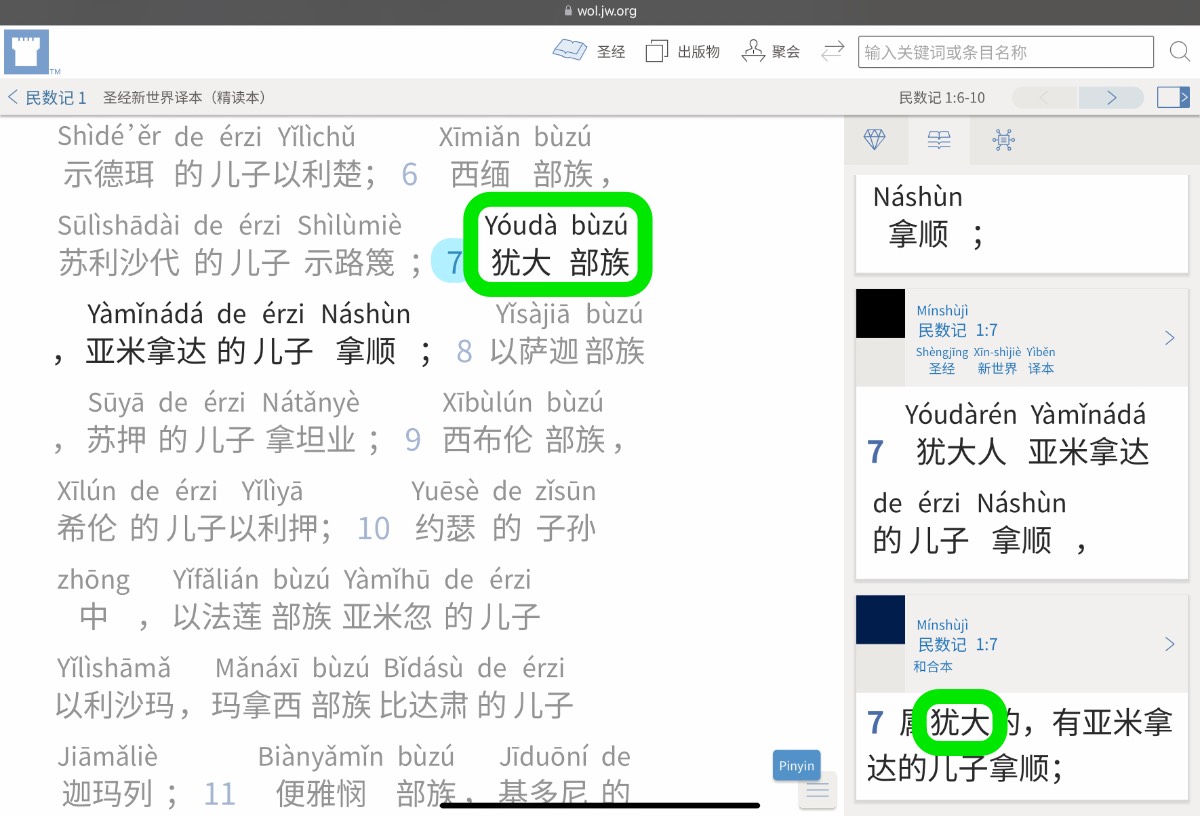bùzú (bù·zú sectional · {ethnic group} → [tribe] 部族) ← Tap/click to show/hide the “flashcard”
Appendix A2 of the English New World Translation of the Holy Scriptures (Study Edition), entitled “Features of This Revision”, discusses vocabulary changes that have been made in the current revision, words that have been translated differently than before. As noted in various entries in the excellent resource Referenced Theo. Expressions (RTE), Appendix A2 of the current Mandarin version of the New World Translation Bible (nwtsty) correspondingly discusses words that have been translated differently in the current revision of the Mandarin NWT Bible, compared to how they had been translated before.
Since we base what we say in Jehovah’s service on his Word the Bible, the vocabulary used in it—and the way those vocabulary words are translated—should be reflected in how we speak in our ministry, at our meetings, etc. So, it is beneficial for us Mandarin field language learners to be familiar with the latest thinking from the organization on how Bible terms should be translated into Mandarin.
Adding Context
In past Mandarin Bible translations, a name like “Yóudà (Judah 犹大 猶大)” might be used to refer to a man, a tribe, a nation, etc., and this could cause readers to be confused. So, the current Mandarin version of the New World Translation Bible (nwtsty) translates such names more clearly, for example using “Yóudà (Judah 犹大 猶大) bùzú (bù·zú sectional · {ethnic group} → [tribe] 部族)” to mean “the tribe of Judah”, using “Yóudà (Judah 犹大 猶大) guó (nation 国 國)” to mean “the nation of Judah”, using “Yóudà (Judah 犹大 猶大) dìqū (dì·qū land · region 地区 地區)” to mean “the land of Judah”, etc.—Mínshùjì (Mín·shù·jì {The People} · Numbers · Record → [Numbers] 民数记 民數記) 1:7; Lièwángjì Shàng ((Liè·wáng·jì {Series of} · Kings · Record 列王纪 列王紀) (Shàng Upper 上) → [1 Kings]) 13:1; Níxīmǐjì (Níxīmǐ·jì Nehemiah · Record 尼希米记 尼希米記) 11:3.

By the way, the “bù (part; section [→ [unit; ministry; department; board]] | [mw for large books, films, machines, vehicles, etc.] 部)” in “bùzú (bù·zú sectional · {ethnic group} → [tribe] 部族)” (this week’s MEotW) is also the one that appears in the well-known expression “bùfen (bù·fen part; section · component; share; part; portion 部分)”.
Solving “The Homophone Problem”
A section of the article “Pīnyīn (Pīn·yīn {Piecing Together} · Sounds → [Pinyin] 拼音) Was Plan A” addresses the common contention that Pīnyīn (Pīn·yīn {Piecing Together} · Sounds → [Pinyin] 拼音) is not suitable as a writing system for Mandarin because of the high number of homophones in Mandarin:
Some may object, saying that there are so many homophones in Chinese that the characters are needed to tell them apart from each other. (A homophone is a word that has the same pronunciation as another word, but that has a different meaning from it.) However, consider: When people are just speaking Mandarin, with no characters in sight to help them, do they have problems understanding each other because of all the homophones? Can blind Mandarin-speakers, who cannot see characters, still “see” what people mean when those people speak Mandarin? Native Mandarin-speakers have confirmed to me that no, homophones are not a significant problem in spoken Mandarin—people can use the context and understand each other okay. So, people can use the context and understand each other okay when using Pīnyīn too, since Pīnyīn directly represents the sound of spoken Mandarin.
…
…other ways [besides resorting to characters] to alleviate the problem. Those other ways could include:
- Including as much clarifying context in the written language as is necessary, as is done in the spoken language
- Reducing the number of homophones by
- Adding syllables to existing homophones
The above-described practice used in the current Mandarin NWT, of adding expressions like “bùzú (bù·zú sectional · {ethnic group} → [tribe] 部族)” to expressions like “Yóudà (Judah 犹大 猶大)”, is an example of adding context, and also an example of reducing the number of expressions that sound the same by adding syllables to existing expressions that sound the same, to clarify what means what without resorting to the homophone-enabling crutch that is the characters. In fact, in this case, disambiguation by using different characters is not an option anyway because “Yóudà (Judah 犹大 猶大)” must be written with the same characters whether it means “the man named Judah”, “the tribe of Judah”, “the nation of Judah”, etc. Theoretically, one might contemplate the possibility of using different characters to represent “Judah” depending on whether it refers to “the man named Judah”, “the tribe of Judah”, “the nation of Judah”, etc., but that way lies even madder madness than the madness that already is the Chinese characters!